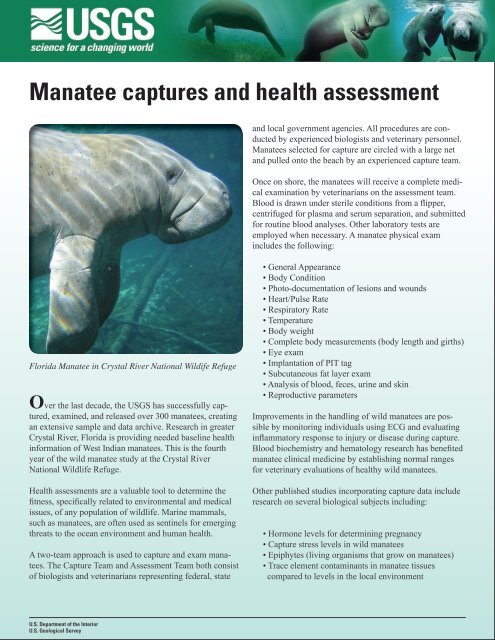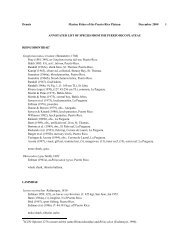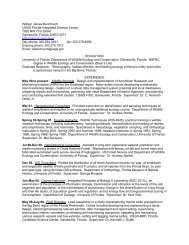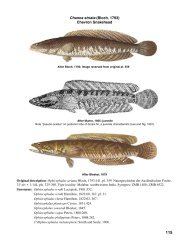Manatee Captures and Health Assessment Handout - USGS
Manatee Captures and Health Assessment Handout - USGS
Manatee Captures and Health Assessment Handout - USGS
Create successful ePaper yourself
Turn your PDF publications into a flip-book with our unique Google optimized e-Paper software.
<strong>Manatee</strong> captures <strong>and</strong> health assessment<br />
Florida <strong>Manatee</strong> in Crystal River National Wildife Refuge<br />
Over the last decade, the <strong>USGS</strong> has successfully captured,<br />
examined, <strong>and</strong> released over 300 manatees, creating<br />
an extensive sample <strong>and</strong> data archive. Research in greater<br />
Crystal River, Florida is providing needed baseline health<br />
information of West Indian manatees. This is the fourth<br />
year of the wild manatee study at the Crystal River<br />
National Wildlife Refuge.<br />
<strong>Health</strong> assessments are a valuable tool to determine the<br />
fitness, specifically related to environmental <strong>and</strong> medical<br />
issues, of any population of wildlife. Marine mammals,<br />
such as manatees, are often used as sentinels for emerging<br />
threats to the ocean environment <strong>and</strong> human health.<br />
A two-team approach is used to capture <strong>and</strong> exam manatees.<br />
The Capture Team <strong>and</strong> <strong>Assessment</strong> Team both consist<br />
of biologists <strong>and</strong> veterinarians representing federal, state<br />
U.S. Department of the Interior<br />
U.S. Geological Survey<br />
<strong>and</strong> local government agencies. All procedures are conducted<br />
by experienced biologists <strong>and</strong> veterinary personnel.<br />
<strong>Manatee</strong>s selected for capture are circled with a large net<br />
<strong>and</strong> pulled onto the beach by an experienced capture team.<br />
Once on shore, the manatees will receive a complete medical<br />
examination by veterinarians on the assessment team.<br />
Blood is drawn under sterile conditions from a flipper,<br />
centrifuged for plasma <strong>and</strong> serum separation, <strong>and</strong> submitted<br />
for routine blood analyses. Other laboratory tests are<br />
employed when necessary. A manatee physical exam<br />
includes the following:<br />
• General Appearance<br />
• Body Condition<br />
• Photo-documentation of lesions <strong>and</strong> wounds<br />
• Heart/Pulse Rate<br />
• Respiratory Rate<br />
• Temperature<br />
• Body weight<br />
• Complete body measurements (body length <strong>and</strong> girths)<br />
• Eye exam<br />
• Implantation of PIT tag<br />
• Subcutaneous fat layer exam<br />
• Analysis of blood, feces, urine <strong>and</strong> skin<br />
• Reproductive parameters<br />
Improvements in the h<strong>and</strong>ling of wild manatees are possible<br />
by monitoring individuals using ECG <strong>and</strong> evaluating<br />
inflammatory response to injury or disease during capture.<br />
Blood biochemistry <strong>and</strong> hematology research has benefited<br />
manatee clinical medicine by establishing normal ranges<br />
for veterinary evaluations of healthy wild manatees.<br />
Other published studies incorporating capture data include<br />
research on several biological subjects including:<br />
• Hormone levels for determining pregnancy<br />
• Capture stress levels in wild manatees<br />
• Epiphytes (living organisms that grow on manatees)<br />
• Trace element contaminants in manatee tissues<br />
compared to levels in the local environment
Selected References<br />
Bonde, R. K., A. A. Aguirre <strong>and</strong> J. Powell. 2004. <strong>Manatee</strong>s<br />
as sentinels of marine ecosystem health: are they the 2000-pound<br />
canaries? Eco<strong>Health</strong> 1:255-262.<br />
Bossart, G. D. 2007. Emerging diseases in marine mammals:<br />
from dolphins to manatees. Microbe 2:544-549.<br />
Harr, K., J. Harvey, R. Bonde, D. Murphy, M. Lowe, M.<br />
Menchaca, E. Haubold <strong>and</strong> R. Francis-Floyd. 2006. Comparison<br />
of methods used to diagnose generalized inflammatory disease in<br />
manatees (Trichechus manatus latirostris). Journal of Zoo <strong>and</strong><br />
Wildlife Medicine 37(2):151-159.<br />
Harr, K. E., N. J. Szabo, M. Cichra <strong>and</strong> E. Phlips. 2008a.<br />
Debromoaphysiatoxin in Lyngbya-dominated mats on manatees<br />
(Trichechus manatus latirostris) in the Florida King’s Bay ecosystem.<br />
Toxicon 52:385-388.<br />
Harr, K. E., K. Allison, R. K. Bonde, D. Murphy <strong>and</strong> J. W.<br />
Harvey. 2008b. Comparison of blood aminotransferase methods<br />
for assessment of myopathy <strong>and</strong> hepatopathy in Florida manatees<br />
(Trichechus manatus latirostris). Journal of Zoo <strong>and</strong> Wildlife<br />
Medicine 39(4):180-187.<br />
Harvey, J. W., K. E. Harr, D. Murphy, M. T. Walsh, E. J. Chittick,<br />
R. K. Bonde, M. G. Pate, C. J. Deutsch, H. H. Edwards <strong>and</strong><br />
E. M. Haubold. 2007. Clinical biochemistry in healthy manatees<br />
(Trichechus manatus latirostris). Journal of Zoo <strong>and</strong> Wildlife<br />
Medicine 38(2):269-279.<br />
Harvey, J. W., K. E. Harr, D. Murphy, M. T. Walsh, E. C.<br />
Nolan, R. K. Bonde, M. G. Pate, C. J. Deutsch, H. H. Edwards<br />
<strong>and</strong> W. L. Clapp. In press. Hematology of healthy manatees<br />
(Trichechus manatus). Veterinary Clinical Pathology.<br />
Moore, S. E. 2008. Marine mammals as ecosystem sentinels.<br />
Journal of Mammalogy 89:534-540.<br />
O’Shea, T. J. <strong>and</strong> D. K. Odell. 2008. Large-scale marine ecosystem<br />
change <strong>and</strong> the conservation of marine mammals. Journal<br />
of Mammalogy 89:529-533.<br />
Siegal-Willott, J., A. Estrada, R. Bonde, A. Wong, D. J. Estrada<br />
<strong>and</strong> K. Harr. 2006. Electrocardiography in two subspecies<br />
of manatee (Trichechus manatus latirostris <strong>and</strong> T. m. manatus).<br />
Journal of Zoo <strong>and</strong> Wildlife Medicine 37(4):447-453.<br />
Stavros, H-C.W., R. K. Bonde <strong>and</strong> P.A. Fair. 2008. Concentrations<br />
of trace elements in blood <strong>and</strong> skin of Florida manatees<br />
(Trichechus manatus latirostris). Marine Pollution Bulletin<br />
56:1221-1225.<br />
Tripp, K. M., J. P. Verstegen, R. K. Bonde, C. J. Deutsch, M.<br />
Rodriguez, C. Manire, J. Gaspard <strong>and</strong> K. E. Harr. In press.<br />
Peracute <strong>and</strong> chronic stress analysis in Florida manatees<br />
(Trichechus manatus latirostris). General <strong>and</strong> Comparative<br />
Endocrinology.<br />
Tripp, K. M., J. P. Verstegen, C. J. Deutsch, R. K. Bonde,<br />
M. Rodriguez, B. Morales, D. L. Schmitt <strong>and</strong> K. E. Harr. 2008.<br />
Validation of a serum immunoassay to measure progesterone<br />
<strong>and</strong> diagnose pregnancy in the West Indian manatee (Trichechus<br />
manatus). Theriogenology 70:1030-1040.<br />
Swimmer <strong>and</strong> a wild manatee in Crystal River National<br />
Wildlife Refuge, Fla<br />
For additional information, please contact:<br />
Robert K. Bonde<br />
<strong>USGS</strong> Florida Integrated Science Center<br />
2201 NW 40th Terrace<br />
Gainesville, FL 32605-3574<br />
Phone: 352-264-3555<br />
Fax: 352-374-8080<br />
rbonde@usgs.gov







